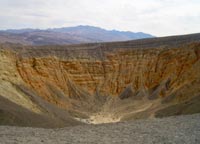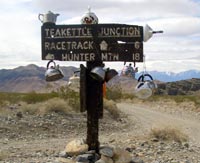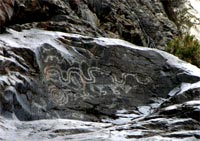Getting
Out There: |
Directory of all "Getting Out There" Articles> |
Racetrack Playa & the Mysterious Sliding Stones
by Mark Sedenquist
|
Living in Las Vegas, Nevada, I find it easy to imagine that all that goes on around us can be explained or manipulated by other humans. The growth of a city of nearly two million residents in one of the driest places in the Americas, the wonder and artistry of the various strip performers and shows and the sheer exuberance of a municipality that seems to thrive on reinventing itself at least once every couple of weeks tends to reinforce the notion that we, as humans, have it all figured out.
So, it may come as some surprise to learn that a couple of hours northwest of the Strip is a road that uses discarded tea kettles as navigation beacons and a dry lake bed featuring a geologic conundrum that continues to baffle scientists and entertain visitors. A couple of days ago, I joined some fellow road adventurers and traveled to the Racetrack Playa in the extreme northwest section of Death Valley National Park. The Racetrack Playa is accessible by a graded -- albeit poorly -- gravel road that extends from the paved road just to the west of the Ubehebe Crater near the Grapevine Ranger Station.
Some who look into the gaping mouth of the Ubehebe Crater see only a large hole in the ground, but to my fellow road tripper, physicist John Tsitouras, who calibrated many of the underground nuclear test explosions in the early 1960s at the Nevada Test Site, "this was a mega-megaton explosion of at least 500 kilotons." The Ubehebe Crater was formed only about two thousand years ago when super heated magma came in contact with water-bearing rock and resulted in a series of massive explosions of steam and rocks. This hydrovolcanic eruption left a hole about 770 feet deep and half a mile wide and created a debris field about 150 feet thick. There are over a dozen similar volcanoes in the area.
Next: Racetrack Playa>
Mark Sedenquist
April 23, 2006



